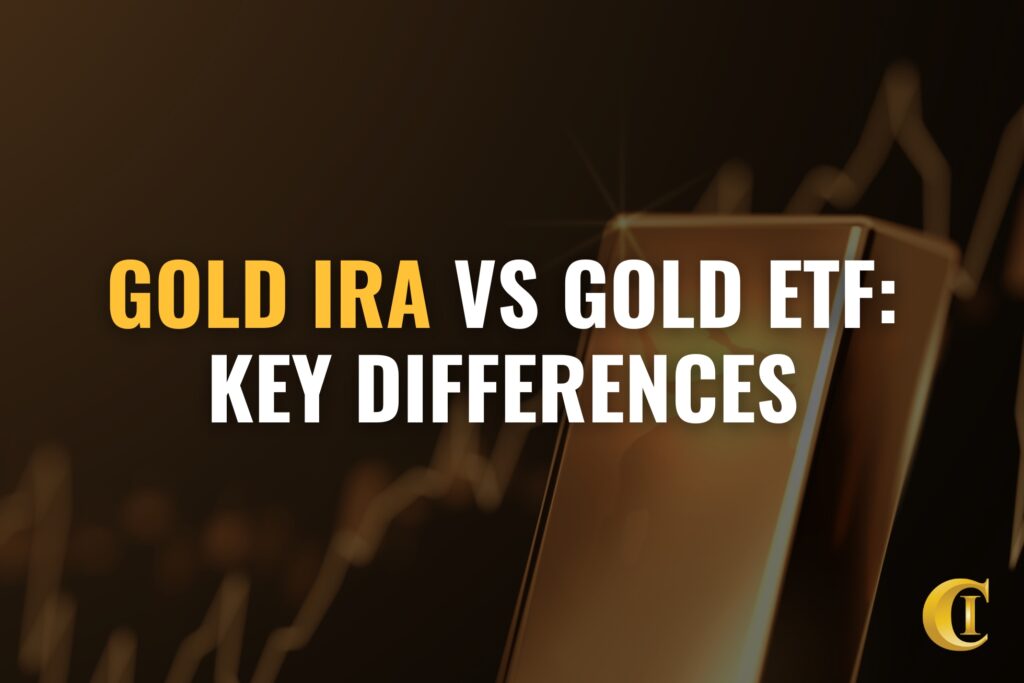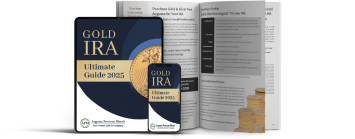Gold IRA vs Gold ETF: Side-by-Side Comparison
This article highlights advantages and risks of a gold IRA vs gold ETF, provides comparative analyses with real-world examples, and addresses frequently asked questions.

Written by Rick Erhart
Rick Erhart is an experienced precious metals professional with more than ten years in the field. He earned a degree in finance and is widely regarded as a specialist in self-directed IRAs.
Gold has captivated investors for centuries, serving as a symbol of wealth, stability, and security in times of economic turmoil.
But with various investment vehicles available, how do you decide the best way to incorporate gold into your strategy? In modern days, at least two prominent options stand out: the Gold Individual Retirement Account (IRA) and the Gold Exchange-Traded Fund (ETF).
These approaches offer exposure to gold but differ significantly in structure, benefits, risks, and suitability for different investor profiles.
If you’re considering a gold IRA but unsure where to start, download a free gold IRA guide. It explains the key benefits and drawbacks of gold investing, including fees, tax implications, potential risks, and more to help you decide wisely.

Brief Overview
A Gold IRA is a self-directed Individual Retirement Account (IRA) allowing investments in physical precious metals like gold bullion, coins, or bars, rather than just stocks or bonds. It’s designed for retirement savings with tax-deferred growth, and requires storage in an IRS-approved depository managed by a custodian.
Gold IRAs appeal to investors diversifying retirement portfolios with physical gold or other precious metals as a hedge against systemic risks. However, gold IRAs involve higher fees, lesser liquidity, and complex IRS regulations. Potential investors should also be cautious of gold ira scams when selecting gold IRA companies.
A Gold ETF is an Exchange-Traded Fund that trades like a stock on exchanges, with its value tracking gold prices. The fund holds physical gold in vaults or uses derivatives to replicate performance, providing exposure without personal ownership or storage.
Gold ETFs offer indirect gold price exposure through shares, enabling easy investing without physical handling. A gold ETF offers high liquidity and low costs, though without tangible ownership like in a gold IRA.
Continue reading to explore the differences between gold IRAs and gold ETFs and decide which suits your needs.
Which Is Better for You: A Gold IRA or a Gold ETF?
Both gold IRAs and gold ETFs are effective investment vehicles, but they serve different purposes for different goals.
To put it simply, deciding between a gold IRA or a gold ETF essentially comes down to your specific investment objectives. You should consider your investment horizon, budget, risk tolerance, and goals.
| Factor | Gold IRA Preference | Gold ETF Preference |
|---|---|---|
| Investment Horizon | Long-term | Short-term |
| Budget | Higher tolerance for fees | Lower costs |
| Risk Tolerance | Stability through physical ownership and discipline | Market swings with quick liquidity |
| Primary Goal | Retirement security and estate planning | Tactical diversification and scalability |
For those investors comparing different retirement options, you might also explore gold IRA vs 401(k) to see how it stacks up against traditional employer plans.
Advantages of a Gold IRA Over Gold ETF
Physical Ownership
Unlike ETFs that provide only paper-based exposure through fund shares, a gold IRA allows direct ownership of physical gold. It offers a genuine hedge against counterparty risks, fund closures, or systemic financial failures where digital assets might falter.
Better Tax Efficiency in Retirement
Gold IRAs benefit from IRA-specific rules, enabling tax-deductible contributions (traditional) or tax-free withdrawals (Roth), with deferred growth compounding without annual taxes. These advantages not inherently available in standard ETF holdings outside retirement accounts.
Tax Benefits
Tax-deferred or tax-free growth allows for unhampered compounding. For a $50,000 investment growing at 5% annually, tax advantages can significantly boost net worth.
Built-in Long-Term Discipline
The structure enforces holding until age 59½ to avoid penalties, discouraging short-term trading and promoting retirement-focused stability. ETFs, on the contrary, encourage frequent adjustments due to easy liquidity.
Enhanced Estate Planning
Assets pass to heirs via beneficiary designations, bypassing probate and immediate taxes with potential stepped-up basis. This provides better legacy preservation compared to ETFs, which lack this seamless inheritance mechanism.
Downsides of a Gold IRA Compared to a Gold ETF
Higher Operational Complexity
Requires selecting IRS-approved custodians and depositories, with mandatory third-party storage and compliance checks. This contrasts with ETFs’ simple brokerage-based trading without such administrative layers.
Limited Accessibility for Smaller Investors
Higher minimum investments ($10,000-$50,000) and fixed fees (e.g., $50-$200 storage annually) make it less suitable for modest portfolios, while ETFs allow entry with shares as low as $73 and no storage burdens.
Restricted Flexibility
Cannot take physical possession early without penalties (10% plus taxes), and RMDs force distributions at set ages, limiting control unlike ETFs’ anytime access.
Potential for Regulatory Pitfalls
Strict IRS purity and transaction rules (e.g., no personal gold additions) increase error risks leading to account disqualification, a concern absent in ETFs’ lighter oversight.
Benefits of a Gold ETF Over a Gold IRA
Better Liquidity for Quick Trades
ETFs trade like stocks during market hours with high volumes, enabling instant sales or adjustments to capture short-term gains. IRAs, on the other hand, involve multi-day liquidation processes involving custodians.
Lower and More Predictable Costs
Expense ratios (0.09%-0.60%) are minimal and scalable, with no separate storage or custodian fees. This makes ETFs cheaper for active or small-scale investing compared to IRAs’ layered annual charges.
Ease of Entry and Scalability
Low share prices ($73-$356) and fractional buying allow broad accessibility without minimums, appealing to beginners or diversified portfolios, whereas IRAs often demand larger commitments.
Seamless Integration Without Retirement Ties
Can be held in any account type for tactical diversification, avoiding IRA age restrictions and penalties, providing more versatile portfolio management.
Downsides of a Gold ETF Compared to a Gold IRA
No Physical Ownership
Relies on fund managers and trustees for gold custody, exposing investors to tracking errors, deviations from NAV during volatility, or fund-specific risks like closures. These issues can be avoided with IRA’s direct physical holdings.
Inferior Tax Treatment
Long-term gains taxed at 28% as collectibles (higher than standard 20% for securities), with no built-in deferral unless wrapped in an IRA. This erodes profits more than gold IRAs’ retirement-optimized structure.
Vulnerability to Short-Term Impulses
High liquidity can lead to emotional trading, potentially missing long-term gold appreciation, while IRAs’ barriers encourage disciplined holding.
No Legacy Optimization
Transfers to heirs treated as standard assets, potentially incurring probate or immediate taxes without IRA’s beneficiary perks, reducing efficiency for generational wealth transfer.
Detailed Comparison of Gold IRAs and Gold ETFs
To truly understand which option might suit you, it’s essential to figure out the core differences of both investment vehicles. While both provide gold exposure, their mechanics, implications, and investor appeal vary widely.
Tax Benefits and Implications
Tax treatment is a pivotal differentiator. Gold IRAs offer retirement-specific advantages: tax-deferred growth in traditional versions, where gains aren’t taxed until withdrawal, potentially at a lower rate in retirement.
- Roth variants provide tax-free withdrawals.
- Contributions can be tax-deductible, and there’s no immediate tax on growth, making it efficient for long-term compounding.
In contrast, gold ETFs incur taxes upon sale: 28% on long-term gains as collectibles, which can erode profits compared to standard investments. No deductions for contributions exist outside of an IRA wrapper, and frequent trading can complicate tax planning with short-term rates applying.

However, if held within a retirement account like an IRA, they can benefit from the account’s tax structure, though this doesn’t change their underlying classification.
Notably, purchasing Gold ETF shares avoids additional taxes like sales tax, value-added tax (VAT), or wealth tax that might apply to physical gold buys.
Fees and Costs
Costs can significantly impact returns over time. Gold IRAs involve multiple layers: setup fees, annual custodian charges ($75-$250), storage fees ($50-$200), and sometimes shipping or insurance. These fixed costs make gold IRAs more expensive for smaller accounts but scalable for larger ones.
Gold ETFs are leaner, with expense ratios of 0.2%-0.8% and occasional brokerage fees. No storage or insurance is needed, as the fund handles that. Over decades, compounding ETF fees might reduce returns by several percentage points, but they remain lower than IRA overhead for active traders.
Operational costs for gold ETFs are relatively low, featuring annual expense ratios typically between 0.09% and 0.60%. For example, a 0.40% expense ratio on a $10,000 investment equates to $40 annually. Brokerage fees may apply for trades, but many platforms offer commission-free trading.
| Fee Type | Gold IRA | Gold ETF |
|---|---|---|
| Setup Fees | Varies, often $50-$100 | None |
| Annual Custodian/Expense Ratio | $75-$250 | 0.09%-0.60% |
| Storage Fees | $50-$200 | Included in expense ratio |
| Brokerage Fees | N/A | Occasional, often commission-free |
| Other | Shipping/insurance | None |
Liquidity and Accessibility
Liquidity measures how quickly you can convert an asset to cash. Gold ETFs excel here, trading like stocks during market hours with high volume ensuring ready buyers and sellers. This allows for nimble responses to price swings.
Gold IRAs are inherently less liquid due to physical assets. Selling requires coordinating with the custodian and depository, potentially taking days or weeks, plus fees for delivery or liquidation. Early access before 59½ triggers penalties, emphasizing their retirement orientation.
Ownership and Risk Profile
With a Gold IRA, you own physical gold, it’s tangible and independent of financial intermediaries beyond the depository. This provides a unique hedge against systemic risks like bank failures, unlike ETFs’ reliance on fund structures. Gold ETFs offer digital ownership of fund shares, not gold itself.
Risks include tracking errors, fund mismanagement, or closures, where you might be forced to sell at inopportune times. However, they avoid theft or storage concerns.
While convenient, ETFs can experience tracking errors like slight discrepancies between the fund’s performance and actual gold prices due to management inefficiencies or market volatility.
During extreme conditions, ETF prices might deviate from the net asset value (NAV) of the underlying gold.
Performance and Returns
Both track gold prices, but nuances exist. Physical gold in IRAs delivers pure returns minus fees, while ETFs might lag due to expenses. For example, as of October 2025, one-year returns for physical gold were approximately 46.5%, while major ETFs ranged from 44%-46%.
Over five years, physical gold returned about 104.5%, compared to 99.3% for GLD, highlighting fee drag.
| Aspect | Gold IRA | Gold ETF |
|---|---|---|
| Price/Entry | Spot price + markup; higher minimums | $73-$356 per share; low entry |
| Costs | Storage ($50-$200), custodian ($75-$250) | Expense ratio (0.09%-0.60%), brokerage fees |
| One-Year Return (Oct 2025) | ~46.5% | 44%-46% |
| Ownership | Physical, tangible with legacy benefits | Digital shares |
| Liquidity | Low; time-consuming process | High; trade like stocks |
| Tax on Gains | Deferred; income tax on withdrawals | 28% long-term capital gains |
Why Choose a Gold IRA?
Gold IRA Pros: Physical ownership for tangibility, superior tax efficiency in retirement, built-in long-term discipline, enhanced estate planning. Gold IRAs typically suit retirement-focused, low-risk investors willing to pay for tangibility and tax benefits.
The process of setting up a gold IRA involves selecting a custodian. This is a financial institution or specialized company that manages the account on your behalf to ensure compliance with IRS regulations. To help with this, consider reviewing the best companies for a gold ira for reliable options.
The physical gold must be stored in an IRS-approved depository, which provides secure, insured vaulting. This third-party storage is mandatory to maintain the account’s tax-advantaged status, and investors receive periodic statements detailing their holdings.
Annual storage fees for these depositories generally range from $50 to $200, depending on the provider and the value of assets stored, while custodian fees can add another $75 to $250 per year.
One of the standout features of a physical gold IRA is its alignment with retirement planning timelines. You cannot take physical possession of the gold until you reach age 59½ without incurring penalties, which include a 10% early withdrawal fee plus ordinary income taxes.

When you reach Required Minimum Distributions (RMDs) age, you are required to start withdrawing a portion of your account annually, either in the form of physical metal or its cash equivalent.
The RMD age is 73 for individuals born between 1951 and 1959, and 75 for those born in 1960 or later. This structure encourages long-term holding, making it ideal for buy-and-hold strategies.
Tax-wise, gold IRAs mirror traditional IRAs. Contributions may be tax-deductible based on your income and other retirement accounts, and investment growth is tax-deferred until withdrawal.
For those opting for a Roth gold IRA, qualified withdrawals in retirement are entirely tax-free, which can be advantageous if you anticipate being in a higher tax bracket later or expect tax rates to rise.
Why Choose a Gold ETF?
Gold ETF Pros: Superior liquidity for quick trades, lower and more predictable costs, ease of entry and scalability, seamless integration without retirement ties. If you prioritize liquidity, low costs, and short-term flexibility, opt for a gold ETF.
A Gold ETF, or Exchange-Traded Fund, is a publicly traded investment vehicle that tracks the price of gold by holding physical gold bullion, bars, or coins in secure vaults, or sometimes through gold derivatives. Investors buy shares of the ETF on stock exchanges, much like trading stocks, with each share representing a fractional interest in the fund’s gold holdings.
Should You Have Both a Gold IRA and a Gold ETF?
Ultimately, neither is superior. They complement diverse portfolios. By weighing your financial goals against these factors, you can select the option that strengthens your wealth-building journey.
Gold IRAs and ETFs both unlock the benefits of gold investing, but they serve different needs.
- Gold IRAs emphasize physical ownership, superior tax efficiency, built-in discipline, and enhanced estate planning for retirement security, ideal for patient, long-term investors despite higher costs.
- Gold ETFs deliver superior liquidity, lower costs, ease of entry, and seamless integration without retirement ties, better for agile, short- to medium-term strategies, though with potential tracking issues and inferior tax treatment.
Frequently Asked Questions (FAQs)
Are gold ETFs as safe as gold?
Safety depends on preference. ETFs avoid physical risks like theft but face fund vulnerabilities. Physical gold in IRAs offers tangibility but requires secure storage. Both are safe with trusted providers.
Should I buy real gold or an ETF?
Assess your profile: risk tolerance, goals, and timeline. Real gold (via IRA) preserves wealth long-term, while ETFs offer convenience for short-term gains. Research performance and consult experts. Physical gold often edges out in extended periods.
Is a gold ETF good for the long term?
Potentially, for diversification, but fees and taxes may hinder compared to physical gold. It suits if your strategy includes liquidity; otherwise, evaluate against IRAs for retirement.
Conclusion
Gold IRAs emphasize physical ownership for tangibility, superior tax efficiency, built-in long-term discipline, and enhanced estate planning for retirement security, ideal for patient, long-term investors despite higher costs and complexity.
Gold ETFs deliver superior liquidity, lower costs, ease of entry, and seamless integration without retirement ties, better for agile, short- to medium-term strategies, though with lack of physical security and inferior tax treatment.
